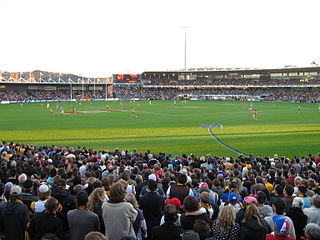The history of Tasmania begins at the end of the Last Glacial Period when it is believed that the island was joined to the Australian mainland. Little is known of the human history of the island until the British colonisation of Tasmania in the 19th century.

Roy Cazaly was an Australian rules footballer who played for South Melbourne and St Kilda in the Victorian Football League (VFL). He also represented Victoria and Tasmania in interstate football, and after his retirement as a player, turned to coaching. Known for his ruck work and high-flying marks, he inspired the common catchphrase "Up there, Cazaly!", which in 1979 became a popular song of the same name, securing his place in Australian folklore.

York Park is a sports ground in the Inveresk and York Park Precinct, Launceston, Australia. Holding 19,500 people, York Park is known commercially as University of Tasmania (UTAS) Stadium and was formerly known as Aurora Stadium under a previous naming rights agreement signed with Aurora Energy in 2004. Primarily used for Australian rules football, its record attendance of 20,971 was set in June 2006, when Hawthorn Football Club played Richmond Football Club in an Australian Football League (AFL) match.
Nonda Katsalidis is a Greek-Australian architect. He is currently a practising director of architecture firm Fender Katsalidis Architects in partnership with Karl Fender.

The Capitol is an historic Australian theatre on Swanston Street in the central business district (CBD) of Melbourne, Victoria. Opened in 1924 as part of the Capitol House building, the art deco theatre was designed by American husband and wife architects Walter Burley Griffin and Marion Mahony Griffin. It is the oldest of Melbourne's large picture palaces and is known for its extravagant decor and abstract motifs, including an intricate geometric ceiling containing thousands of coloured lamps designed to evoke the walls of a crystalline cave.
Australian non-residential architectural styles are a set of Australian architectural styles that apply to buildings used for purposes other than residence and have been around only since the first colonial government buildings of early European settlement of Australia in 1788.
Antony John Jereos Lekatsas (1862–1946), best remembered as Anthony J. J. Lucas, was an influential Australian businessman noted for his philanthropic activities and as proprietor and developer of a number of noted entertainment and restaurant ventures in Melbourne, Australia in the early 20th century. Lucas became the Greek Consul General to Australia in 1921, then Consul in Melbourne in 1931–46.
Andreas Lekatsas was a Greek who was a native of the Greek island of Ithaca and was one of the first Greeks to migrate to Australia. He arrived in Melbourne before 1851 and initially moved to the goldfields of Ballarat. He soon found wealth, and a return journey to Ithaca inspired his nephews Anthony JJ Lucas and Marino Lucas to also move to Australia. Andreas may have taken part in the Eureka Stockade uprising, as the following passage from the Ithacan Philanthropic Society details.
Indeed a number of Ithacans went on to Melbourne after the gold-fields to make a living there. Andreas Lecatsas from Exoghi, Ithaca is said by his descendants to have jumped ship in 1851 to join the gold rush. Later he prospered as a Melbourne shop-keeper and returned to Ithaca some 20 years later to inspire some of his nephews to emigrate. Indeed, one nephew Antonios Lekatsas heeded his advice to see the new El Dorado and landed in Melbourne in 1877. It is said, but not authenticated that Andreas Lecatsas was present at the diggers’ stand at the Eureka Stockade near Ballarat in 1854.
Terence Robert Cashion was an award-winning Australian rules footballer from Tasmania who played numerous representative matches for the state and also played for South Melbourne in the Victorian Football League (VFL).
Majestic Theatre or Majestic Theater may refer to:
James Blackburn was an English civil engineer, surveyor and architect best known for his work in Australia, where he had been transported as a sentence for forgery. According to the Australian Dictionary of Biography, Blackburn "has claims to be considered one of the greatest engineers of his period in Australia, and his architectural achievements established him as Tasmania's most advanced and original architect." He was key to the formation of the Department of Public Works in 1839, serving as one of its core members under Alexander Cheyne.
Alan Gordon Forcett Scott was an Australian rules footballer who played for St Kilda in the Victorian Football League (VFL). He also had a noted career in Tasmania in both the Northern Tasmanian Football Association (NTFA) and Tasmanian Football League (TFL).
Henry Colin Strang was an Australian rules footballer who played with St Kilda in the Victorian Football League (VFL).

John Cyril "Jack" Cato, F.R.P.S. was a significant Australian portrait photographer in the pictorialist style, operating in the first half of the twentieth century. He was the author of the first history of Australian photography; The Story of the Camera in Australia (1955)
The Tasmanian Heritage Register is the statutory heritage register of the Australian state of Tasmania. It is defined as a list of areas currently identified as having historic cultural heritage importance to Tasmania as a whole. The Register is kept by the Tasmanian Heritage Council within the meaning of the Tasmanian Historic Cultural Heritage Act 1995. It encompasses in addition the Heritage Register of the Tasmanian branch of the National Trust of Australia, which was merged into the Tasmanian Heritage Register. The enforcement of the heritage's requirements is managed by Heritage Tasmania.

The Princess Theatre is a historic theatre in Launceston, Tasmania, Australia.

The National Theatre is a historic former theatre in Launceston, Tasmania, Australia.

The Majestic Theatre is a historic former theatre and cinema in Launceston, Tasmania, Australia.







